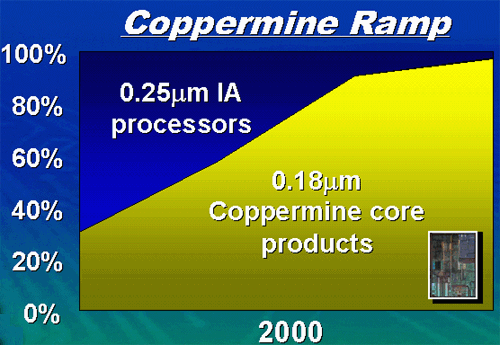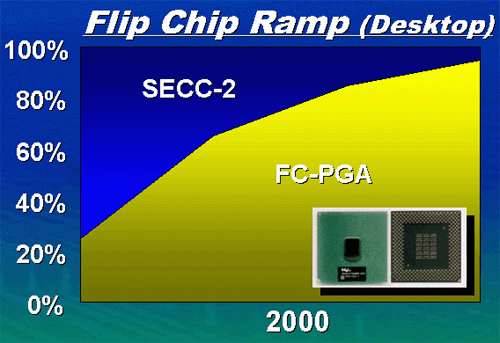Intel Pentium III E "Coppermine" (Slot-1)
by Anand Lal Shimpi on October 25, 1999 7:21 PM EST- Posted in
- CPUs
0% Copper
Intel’s latest addition to the Pentium III line of processors is what we’ve referred to as the "Coppermine" CPU. Coppermine is one of Intel’s many codenames for pre-production processors and doesn’t mean that the processor is based on copper technology.
0.18-micron core
The differences between the Pentium III E and all previous Pentium III CPUs begin with the new 0.18-micron core. All previous Pentium III CPUs were manufactured on the 0.25-micron fabrication process.
The good news is that the transition from 0.25-micron to 0.18-micron is going very smoothly. Part of the reason for this is because Intel started the transition to 0.18-micron very early on. On June 14, 1999, Intel released their first 0.18-micron CPU, the mobile Pentium II 400. The CPU featured 256KB of on-die L2 cache operating at clock speed which helped bring up the total transistor count to 27.4 million transistors for a single mobile chip. Why does this matter?
Intel has a history of trying out technologies on their mobile parts before bringing them to desktops. At the time the 0.18-micron mobile Pentium II 400 was produced, it wouldn’t have been profitable for Intel to shift their entire production line to 0.18-micron for desktop CPUs. The beauty of mobile chips is that the demand for them isn’t nearly as great as desktop CPUs, so Intel doesn’t have to manufacture as many. This way, they can try out a new manufacturing process on a few CPUs, work towards perfecting it, and then eventually apply it to the bulk of their sales -- desktop CPUs.
The production of the mobile Pentium II 400 went very well and Intel is planning to ramp up production of their 0.18-micron desktop CPUs faster than they have ever done in the past. This is in no way a bad thing, 0.18-micron chips are cheaper to produce and allow more CPUs to be produced per wafer than on the 0.25-micron process.
Intel has four of their fabrication plants primed and ready for the transition to 0.18-micron. By the end of Q1-2000 Intel predicts that half of their Pentium III processors will be the new 0.18-micron Pentium III E chips with that percentage climbing to 100% by the end of next year.

Intel is obviously planning on manufacturing the Pentium III E in significant volumes and they have already set a goal for 8xxMHz in the first quarter of the next year.

The 0.18-micron process will also allow for the eventual transition to cheaper socketed CPUs in the year 2000. At the launch of the Pentium III E, only two socketed CPUs will be made available (Pentium III 500E & Pentium III 550E) but by the middle of 2000 over half of all desktop Pentium III E CPUs will be socketed. The cost of producing these socketed, or Flip Chip PGA (FC-PGA) as they are technically known, chips is noticeably less than the cost of producing a Slot-1 SECC2 cartridge chip.
The 0.18-micron core also means quite a bit as far as overclocking potential is concerned. Our 733MHz sample had a nice time hovering around 800MHz and as Intel perfects their 0.18-micron process you can expect these CPUs to become very nice overclockers since they already run so very cool. We will be taking a closer look at the overclocking potential of the 0.18-micron process in the coming weeks.










1 Comments
View All Comments
vortmax2 - Wednesday, February 19, 2020 - link
First! Lol, I remember the days when I could understand what a CPU was all about.